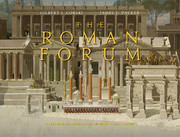Book contents
- Frontmatter
- Map
- Contents
- Preface
- Acknowledgments
- Part I. Architecture in the Roman Forum during the Empire: A Brief History
- 1 The Augustan Reconstruction (31 BCE–14 CE)
- 2 From Tiberius to Phocas (14–608 CE)
- Part II. The Monuments
- Part III. Conclusions
- Glossary
- Notes
- Bibliography
- Sources for Coin Images from the Internet and for Other Images
- Index
1 - The Augustan Reconstruction (31 BCE–14 CE)
from Part I. - Architecture in the Roman Forum during the Empire: A Brief History
Published online by Cambridge University Press: 05 March 2015
- Frontmatter
- Map
- Contents
- Preface
- Acknowledgments
- Part I. Architecture in the Roman Forum during the Empire: A Brief History
- 1 The Augustan Reconstruction (31 BCE–14 CE)
- 2 From Tiberius to Phocas (14–608 CE)
- Part II. The Monuments
- Part III. Conclusions
- Glossary
- Notes
- Bibliography
- Sources for Coin Images from the Internet and for Other Images
- Index
Summary
Prologue: The Republican Forum (508–31)
Established as a meeting place for the inhabitants of the adjacent, previously independent villages, the Republican Forum occupied an irregularly shaped, marshy valley below the Palatine and Capitoline Hills. Reclaiming the central marsh by massive earth fills in the late sixth century, its builders initiated the continuous evolutionary changes that, in the next five centuries (c. 525–44), transformed the site into the Forum of the late Republic. Literary tradition credited the Temple of Vesta at the southeast end of the valley to Rome’s second king, Numa Pompilius (715–673), who had erected it next to the Regia, his own residence. At the northwest end, Pompilius’ successor, Tullius Hostilius (672–641), built the Curia Hostilia, the Senate House named after him, and, in front of it, the Comitium, the outdoor meeting place for Rome’s popular assemblies. At the end of the sixth and the beginning of the fifth centuries, the early republican Temples of Saturn and Castor went up to the south, and, by the fourth century, a line of aristocratic dwellings connected these temples and defined the edges of the piazza (Fig. 1.1).
During the course of the second century, two rectangular basilicas replaced many of these houses. On the north side of the Forum stood the Basilica Fulvia (later called Aemilia), and to the south, the Basilica Sempronia. In the late second century, a temple to Concord on the northwest side of the Forum commemorated an aristocratic victory over the people, and by early in the next century (after 78), the monumental facade of the Tabularium, with its impressive second-story arcade and engaged Doric Order (Figs. 11.1, 2, 6, 9, 10, 21.21), hid the slope of the Capitoline Hill.
- Type
- Chapter
- Information
- The Roman ForumA Reconstruction and Architectural Guide, pp. 3 - 36Publisher: Cambridge University PressPrint publication year: 2015



